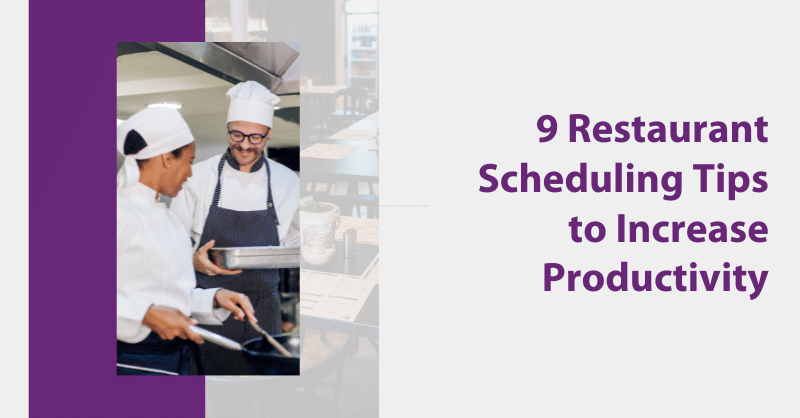Welcome to the world of restaurant scheduling. Get it right and your employees will sing your praises. Get it wrong and you could lose valuable workers. One of the keys to keeping your restaurant running is having an engaged workforce that produces at a high level.
How do you keep morale and profits high? You ensure schedules are fair and consistent—you focus on your restaurant staff schedule strategy. It sounds simple, but investing time in this area could pay huge dividends and help you avoid staff turnover and burnout. Here are 9 tips for effective restaurant scheduling.
1. Listen to your employees
Before you even think about how you’ll improve your restaurant schedules, start by listening to your workers. Consider a simple anonymous questionnaire that asks how they like the way scheduling is going. Also be sure to leave room for open-ended feedback and free response answers.
You can learn a lot about what’s working and what isn’t by taking an interest in what your employees are saying. But don’t stop there. Once you have a pulse on how things are going, be sure to make changes based on the advice. Obviously you won’t be able to accommodate everybody, but you can look for themes and make any necessary adjustments to your restaurant schedule.
2. Post the schedule at a consistent time
Consistency is key when it comes to earning and retaining employee trust. Servers, cooks, and hosts want to know when they can expect to see the weekly schedule. If it’s posted at the same time each week, they can get into a routine. This will also save you a headache as a restaurant owner. People won’t need to ask when the schedule will be posted because they’ll know that it happens at the same time and on the same day every week.
3. Plan a specific weekly time to work on the schedule
Being consistent about schedule posting is great, but it’s tough to do if you don’t have a plan. It’s particularly tough to post a schedule if you don’t have a completed one to post. In other words, you should be diligent and deliberate about when you put the schedule together.
Take some time to review time off requests and have a system for crafting the schedule. If you can set aside time on the calendar and stick to it religiously, you’ll feel much more organized. It’s best to do this a few days before the schedule will actually be posted. This will give you a chance to make any adjustments needed and keep you from feeling overwhelmed.
4. Schedule your highest producing workers for the busiest times
Everyone knows which servers are great at handling pressure. Or the ones who consistently upsell and bring in extra profits. These are the workers you want front and center during your busiest shifts. They’ll not only delight guests, but also help your restaurant make more money.
Giving priority to the most productive and revenue-driving servers also encourages other servers to improve. If they get better at selling more food and providing impeccable service, they’ll get a greater chance to make good money on a busy weekend night.
5. Give everyone a chance
While you do want to have workers you can rely on at your busiest times, you should also give newer employees a chance to step up. You never know how someone might perform until they’re thrust into the fire.
It’s possible some of your newest servers could be some of the most effective. You won’t know unless you give them a chance early on. There could be some diamonds in the rough. And even if they’re not perfect, there’s no better place to learn than on the job during a busy time.
6. Remember your employees are people too
The restaurant business is fast-paced and demanding both physically and mentally. This means you should be extra dedicated when it comes to scheduling days off and granting vacation time and contingencies for emergency situations.
If your workers burn out, they won’t be effective. Be considerate and give them the chance to take some time for themselves. If possible, give them two days off in a row for recuperation. If you show you value their time off requests, chances are they’ll be fresher and more motivated when they are on-shift. Respect them and they’ll most often return the favor.
7. Use restaurant scheduling software
You’d be surprised how many restaurants still use pen and paper to make schedules. Hopefully that’s not the case for you. If it is, don’t worry—there is a better way and better technology, and we’re happy to help.
Our restaurant scheduling software takes the load off and frees you up to focus on improving your restaurant instead of managing personnel. Enjoy automatic restaurant employee schedule creation, easily manage team requests, and get overtime alerts, all through an easy-to-use software solution.
8. Know the answers to these questions
What are typical restaurant shifts? How do restaurants schedule employees? What is the 5 4 9 work schedule? As a restaurant owner, you should know the answers to these like the back of your hand. If you don’t, here’s a helpful refresher.
What are typical restaurant shifts?
Restaurant shifts are sometimes split into four-hour increments. One four-hour shift works the first half of the day, and the other works the next half. Occasionally shifts can be longer and there can be some overlap, but generally one shift might be 11 a.m. to 3 p.m. and the next might be 3 p.m. to 7 p.m. with the final one being 7 p.m. to 11 p.m.
Some restaurants use a split-shift model where a server might work a few hours around breakfast and a few more around dinner. Overall, it’s best to understand the needs of your specific restaurant and the limitations of your staff and plan accordingly.
What is the 5 4 9 work schedule?
The 5-4-9 work schedule is a modified schedule that works will for the restaurant industry. It essentially ensures you have coverage and that employees get not too many or too few hours while splitting up work. It means that each employee will work eight 9-hour days and one 8-hour day, for a total of 80 hours over two weeks.
How do restaurants schedule employees?
Restaurants schedule employees by taking in the information they need and then setting aside time and systems to create a schedule. Many restaurant owners use restaurant scheduling software to make their job easier.
9. Remember to reevaluate often
It’s best to reevaluate your restaurant scheduling strategy at least once a quarter to see what’s working and what isn’t. Remember to gather feedback from employees regularly and take time to look for trends to see which workers are most effective during certain times. Over time, you’ll get a feel for who works best under which circumstances in order to keep staff happy while also increasing profits.
Restaurant scheduling software is just one of the many helpful tools we offer. Reach out today if you’re ready to get started on running a more profitable restaurant.





